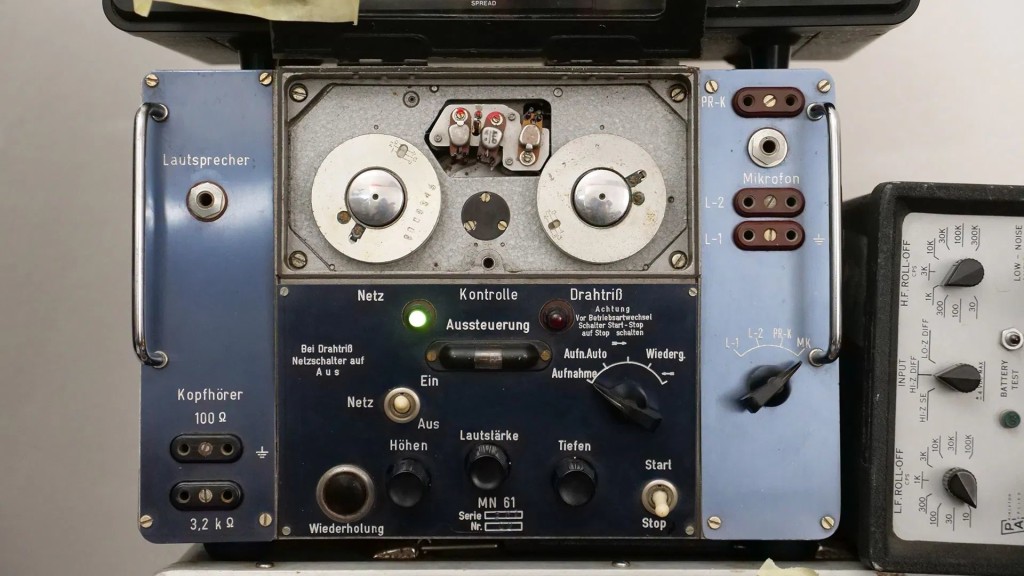It’s terrible recording technology, made into wonderful music tool. This 1970s Soviet machine saw Cold War spy and military action – but now you get to cheat and use it as a plug-in.
Berlin’s Hainbach has pretty much made it his brand finding fresh musical uses for vintage gear – the one and only YouTube influencer pushing mid-century audio technology. Now we’re seeing him release software to the audience he’s built, with collaborations with different developers. He’s already transformed his tube oscillator collection into Fundamental, as covered here in-depth. This time, we get to rock that mix like we’re undercover with the Stasi.
So, wire recorders?
The MN-61 that inspired WIRES is a 1961 product from the Vilma National Devices factory in Vilnius, Lithuania. (It wasn’t an all Baltic build; the innards were the work of the Petrovskovo Works in Novrogod, just down the river from Leningrad.) What you sacrifice in quality on these devices, you make up in recording time – a full five and a half hours. Now, Vilma made consumer devices, too – even some 80s tape recorders that you might confuse with western models if you didn’t read the labels. But as there wasn’t so much use for something like a solid-state wire recorder in everyday Soviet life, this particular gadget had the KGB and Soviet military as consumers. Hainbach describes it as a spy gadget, which was certainly its sexiest use – and note his sports German labels, for use in the DDR by the Stasi. But a smaller version also saw service as a cockpit voice recorder.
Details in Russian:
Бортовые средства объективного контроля
And, oh, it’s beautiful:

See:
https://www.cryptomuseum.com/covert/rec/ussr/mn61/index.htm
https://www.radiomuseum.org/r/vilma_mh_61.html (with specs!)
Hainbach uses this hardware as an effect:
By popular demand, AudioThing and Hainbach reproduced the sound of this machine in software form. The sales pitch – even boring sounds suddenly sound wild and interesting, thanks to tons of inharmonic distortion and nonlinearity and general terrible-Soviet-electronics low fidelity:
So, now that you’ve got the novelty of the concept – and the pretty retro UI – what does it actually do? This isn’t a review as I’ve only just grabbed the plug-in from Hainbach, but here’s the basic run-down.
They’ve reproduced:
- That strange tone from the hair-thin wire used as magnetic recording medium
- Non-linear time effects (wow/flutter, etc.), and speed control and start/stop braking
- Noise, natch (hiss, motor sounds with enveloping) plus irregularities (drops and clicks)
- Vacuum tube output
- Recreations of the internal speaker and mic
— plus it’s an echo, using the simulated wire mechanism, with the expected time / feedback / level and wet/dry controls you’d expect from a modern dedicated echo device. And you get preset storage and randomizer, you spoiled capitalist kids.
Here’s more of what it sounds like:
Here’s another look at their German hardware:


It’s all a devilishly clever idea to make software that does this – and my first impression is certainly that AudioThing have done a bang-up job of the very challenging work of modeling non-linear magnetic recording mechanisms. But it’s also not their first time at the rodeo; they’ve got a full library of hardware modeling plug-ins, including rendering a portable Japanese reel-to-reel, if that’s more your speed.

I’ll say this: I think it’s easier to justify modeling this sort of equipment and it’s so-called “lo-fi” sound than it is making analog recreations of high-end vintage gear intended to be transparent. It’s not just about getting a grungy sound; it’s also that there’s more creative application here. High-end analog recording gear might arguably be perfectly well replaced with even more precise digital equipment, but when it comes to intentionally adding these touches, you can’t beat the old stuff. That’s up for debate, though, and … well, were it legal to gather and have drinks and discuss such things, we’d do that.
For now, this is a fascinating tool. I feel somewhat charged with having to use it on a track creatively without all the legions of Hainbach fans knowing I have.
It’s 39EUR intro; 59 thereafter. A demo is available.
VST2, VST3, AAX (Windows/macOS) and AU (macOS), all 64-bit.
Minimum Windows 7+
Minimum macOS Lion, but up to and including macOS 10.15 Catalina – so if you just got a Catalina machine and it broke all your plug-ins, install this and you can have just a 1961 wire recorder effect, for some irony.
Now, obviously once you have finished your tracks, you’ll want to listen to them on the desktop music player I recommended with USSR-vintage skins: